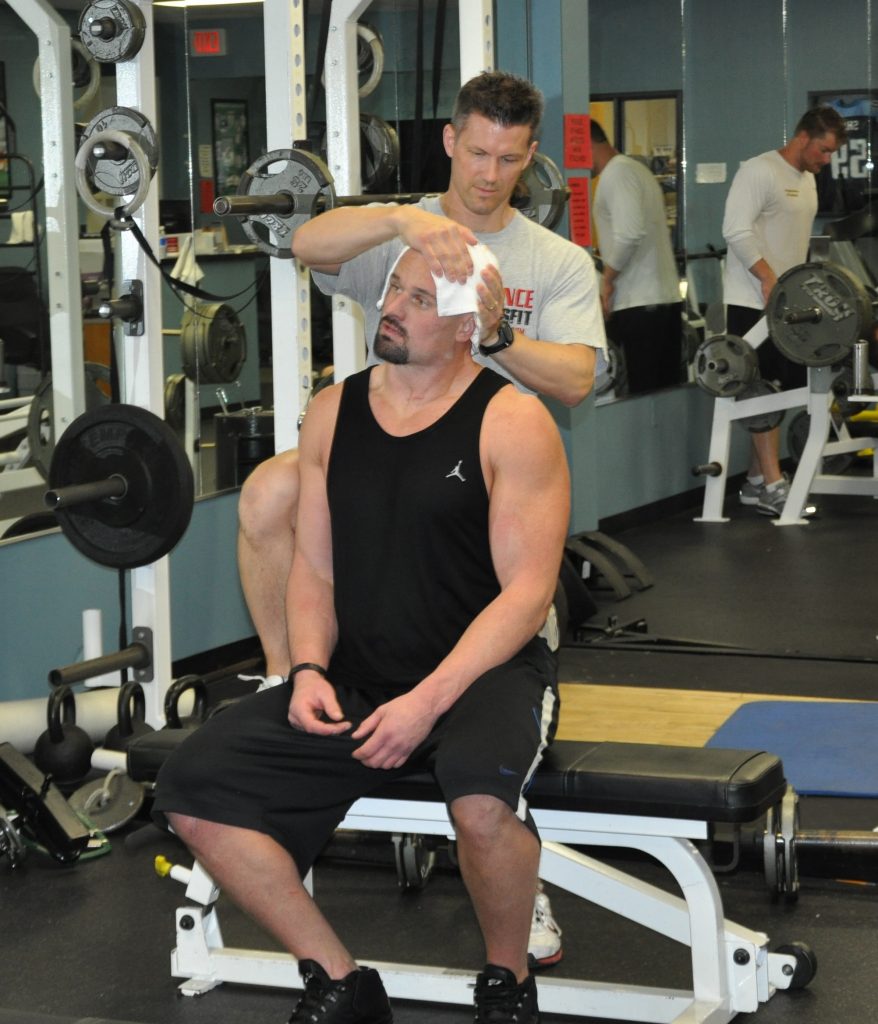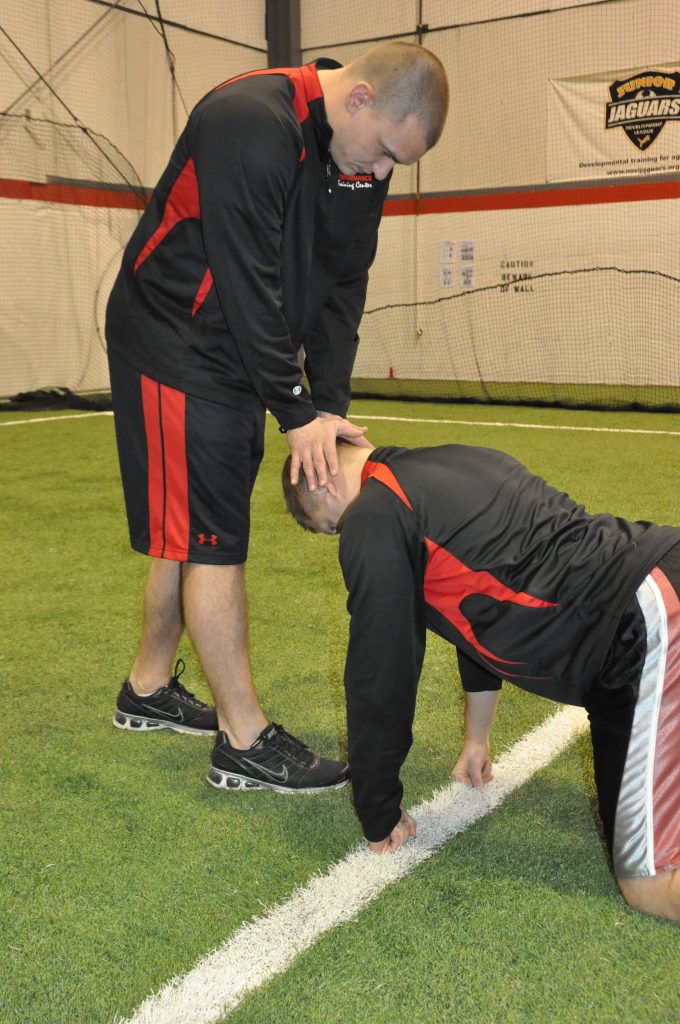Part 2 of 2 on concussion awareness and mitigation for the S&C Professional discusses when and how to program strength training for the neck, as well as exercise variations that can fit any program.
Strength Training the Neck and Its Associated Musculature
Neck training and its importance is not a new-found fad or focus in the strength and conditioning community. However, as part 1 detailed, what has emerged recently is concussion awareness and hopeful prevention has spread from not only the contact sports, but to the non-contact type as well. Clinical diagnosis along with research-based studies are showing athletes in sports that are largely non-contact in nature are at a higher risk of head injury than what may have been previously thought. As we begin to better understand the mechanism and origins of concussions, health care practitioners, S&C professionals, sport coaches, and parents are learning that athletes of both sexes and of all ages and sizes can be affected. Proper understanding that head injuries can, and unfortunately, do frequently occur, is the first step into emphasizing prevention programs and strategies for athletes that were once maybe deemed safe from an injury of this nature.

To hopefully mitigate the number of head-based injuries to their athletes, many strength and conditioning professionals include neck-based training within their programs. Exercise selection to train the neck musculature is quite diverse. Dependent upon the coach, exercises may include machines, plate loaded harnesses, resistance bands, or even a plethora of manual resistance techniques (See IYCA manual resistance video library). There are no shortages of variations of neck training, as coaches utilize training the musculature in all three cardinal planes of movement, as well as focusing in on concentric, eccentric and isometric muscle actions. A well-developed neck training program will emphasize strengthening the musculature through many of the joint actions.
The main joint actions in regards to the training of the neck and shoulder girdle are as follows:
Cervical spine:
- Flexion
- Extension
- Lateral Flexion
- Rotation
- Protraction
- Retraction
Shoulder Girdle:
- Elevation
- Depression
- Protraction
- Retraction
When choosing exercises for neck strength training specifically, it is best to perform exercises that directly work the cervical spine, and to use exercises focusing on the shoulder girdle as more secondary exercises. Training both regions are important, but targeting the neck musculature via cervical spine movements should be performed first and more frequently.
Utilizing the equipment available (or no equipment at all if using a manual resistance variation) and training through an array of both joint and muscle actions will better equip athletes to face the unknown rigors that are in play in athletics.
How, when and where to program neck exercises within a program
Training of the neck and its associated musculature should be placed within a strength training program year round. However, a heightened emphasis should occur during pre-season and in-season periods. These are the times when practices and games are at the forefront and thus more contact/risk of incident of neck related injuries. Even though athletes have limited time in the weight room during these periods of the year, neck training should never take a back seat. What should take place is multiple sets during each workout and even different variations on the other training days of the week. This may include performing different muscle actions each day or changing the joint action performed.

During the off-season is when coaches receive the most time with their athletes and this is the time period where it is imperative to teach the athlete exactly what is expected when performing exercises involving the neck. Our athletes are only as proficient in an exercise as we choose to make them, so it is crucial they receive carefully detailed instruction. Building a great base of exercise knowledge as well as baseline strength in the off-season will in turn provide the blueprint for effective neck training during the pre-season and regular-season.
Like the other major joints in the body, resistance training for the neck can be done multiple times a week. There are many exercise variations possible due to the magnitude of musculature on the cervical spine and shoulder girdle. A balanced approach that encompasses multiple joint actions of the neck and each of the muscle action phases several times a week is recommended.
There is a great degree of variability when choosing on where to program neck exercises into a training block or training session. Regardless of where they take place within a workout, neck associated exercises should be performed in a very careful manner and not ballistic or in a rapid fashion. Because of that fact you’ll typically see coaches perform them at the beginning of a workout in conjunction with movement prep type exercises. This is when athletes are in a non-fatigued state, both physically and mentally, and are more likely to maturely and properly perform the exercise.
It is also common for neck exercises to be done as part of a superset with another lift as a sort of active recovery for a more taxing multi joint exercise or at the end of a workout as an accessory lift. Coaches employ the superset tactic to train neck to utilize their time given with athletes in the weight room. If time is a factor, pairing neck training up with various exercises can be effective. When allowing athletes to pair neck training with other exercises, it becomes difficult to oversee every athlete at once, especially if you a short staffed or even a solo coach. Here it becomes important that the athletes understand exactly how to perform the exercise and they have gained the coach’s full trust.
Modes of Resistance Training for the Neck

Simplicity can be key when choosing exercises to train the neck. Athletes are thrown many multi-joint and difficult exercises at them in a training session. Keeping the neck exercises simple can often yield better results. When training a youth demographic simplicity almost has to take place. Young athletes may not understand the risks associated with head related injuries and may not understand why they are performing these exercises in the first place. In a society where running faster, jumping higher and getting bigger are the expected results of an S&C professional, it’s hard to sell exercises that do not check any of those boxes, even if they are just as, if not more important. Understand your clientele and understand what works best.
Bracing and isometrics for training the neck musculature are both great for simplicity sake, but also because they are incredibly effective. Research by Dempsey et, al (2016) showed that athletes who have displayed higher levels of isometric neck strength exhibited a decrease in acceleration of the skull after an impact, and Collins et al (2014) concluded isometric neck training resulted in an outright decreased overall risk of sustaining a concussion. As unpredictable as sports as a whole may be, so too are the positions the body can be placed in during a game or training session. Because of this, it is wise to include dynamic movements to the neck training repertoire and include both the concentric and eccentric phases when performing an exercise. While isometric holds and bracing both can provide great training residuals for athletes it is best to utilize all three muscle actions within a program. Having increased strength through a greater range of motion can minimize injuries in every joint, and that includes the neck and shoulder girdle. By preparing the athlete to accelerate and decelerate through resistance they better equipped they will be to take on the rigors of sport. Whatever the modality of neck training may be, the goal remains the same. To minimize occurrence of concussion. Such an emphasis is put into dedicating time into sets and reps for the neck because research justifies that it can prevent the occurrence of concussion.
Manual Resistance Exercises
Neck Flexion:
Lateral Neck Flexion:
Isometric Lateral Neck Flexion:
Machine Neck Exercises
Machine Neck Flexion:
Machine Neck Extension:
Machine Neck Lateral Flexion:
Machine Neck “Nod”:
Machine Neck Retraction:
Shoulder Girdle Exercises
Band Pull Apart:
DB Side Raise:
DB Shrug:
DB Upright Row:
Single Arm DB Shrug:
Plate Upright Row:
Band Scapular Retraction:

Joe Powell is an Assistant Strength & Conditioning Coach at Utah State University. He formerly held a similar position at Central Michigan University where he also taught classes in the Department of Health and Human Performance. Joe is a regular contributor to the IYCA Insiders program and has been a huge part of bringing the Behind the Science series to the IYCA. He is also the author of the IYCA Guide to Manual Resistance Strength Training. Get more of Joe’s contributions in the IYCA Insiders membership.


